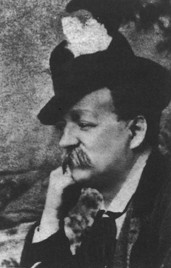Leopold Knebelsberger

Leopold Knebelsberger (born September 15, 1814 in Klosterneuburg , † October 30, 1869 in Riga ) was an Austrian musician and composer .
Life
Leopold Knebelsberger received his first music lessons from his father, who worked for 65 years as a sacristan and organist at the parish church of St. Martin in Klosterneuburg. His mother was the daughter of the village judge from Leobersdorf . Knebelsberger learned to play the violin and organ , as well as dulcimer and guitar .
After his great musical talent was noticed, he was trained in composition and harmony by Conradin Kreutzer (1780–1849) in Vienna . Knebelsberger perfected his violin playing with lessons from Joseph Mayseder (1789–1863).
Until about 1843 Knebelsberger, about whose youth little is known, earned his living by giving music lessons. Also held concerts in his hometown.
In Lübeck Leopold Knebelsberger met the singer Anna Hellmrich and married her on July 31, 1849 in her Bohemian birthplace Preßnitz . The couple bought a property in Preßnitz and had ten children, but rarely stayed at home. After Knebelsberger had already worked as a member of various singing societies , he founded his own singing ensemble in 1849, the " Zillertaler " . He undertook extensive tours through many European countries, on which his wife often accompanied him.
Leopold Knebelsberger died during a concert tour in Riga in 1869.
Although little is known about the whereabouts of his musical legacy, his work is estimated to be around 300 popular songs and instrumentals.
His daughter Marie Knebelsberger became a virtuoso zither player and belonged to a ladies band, whose long concert tours she a. a. led to Egypt. In 1874 she married the clockmaker Auer from Pressnitz. Marie Knebelsberger-Auer also composed.
"To Mantua in gangs" (Andreas Hofer song)
In the 1840s Leopold Knebelsberger set to music a patriotic poem by Julius Mosen (1803–1867), a writer of German Romanticism : “Zu Mantua in Banden” (1831). The verses, also known as the Andreas Hofer Lied , were already popular in the German pre-March period .
There are three theses on the genesis of the composition, the sources of which are still unclear today:
- In 1840 Knebelsberger stayed in Hart in the Zillertal to recruit new singers for his ensemble. They introduced him to Mosen's poem, which prompted him to set it to music.
- In 1844 Knebelsberger read the poem in a Dresden newspaper.
- Allegedly Knebelsberger met Julius Mosen personally as early as the 1840s and wrote a catchy melody for the popular text using old folk tunes.
It is certain that Leopold Knebelsberger directed one of his concert tours to Oldenburg in 1855 , where Julius Mosen had worked as a dramaturge and had been confined to bed since 1846 because of a serious rheumatic disease. To Mosen's great joy, Knebelsberger's music ensemble performed the poem for him.
The Austrian state of Tyrol declared the Andreas Hofer song to be the Tyrolean national anthem by law on June 2, 1948 .
literature
- Christian Fastl: Knebelsberger (Knebelsperger, Knöbelsperger), family. In: Oesterreichisches Musiklexikon . Online edition, Vienna 2002 ff., ISBN 3-7001-3077-5 ; Print edition: Volume 3, Verlag der Österreichischen Akademie der Wissenschaften, Vienna 2004, ISBN 3-7001-3045-7 .
- Knebelsberger Leopold. In: Austrian Biographical Lexicon 1815–1950 (ÖBL). Volume 3, Verlag der Österreichischen Akademie der Wissenschaften, Vienna 1965, p. 434.
Web links
- Sheet music and audio files by Leopold Knebelsberger in the International Music Score Library Project
- The Andreas-Hofer-Lied , Schützenverein Andreas Hofer, Düsseldorf-Oberbilk
- 200th birthday of Julius Mosen , Andreas-Hofer-Bund, Homburg
- On Mantua in Gangs (Andreas Hofer Lied) : Text , German folk song archive; Melody (mp3; 1.13 MB), Provincial Government of Tyrol
| personal data | |
|---|---|
| SURNAME | Knebelsberger, Leopold |
| BRIEF DESCRIPTION | Austrian composer |
| DATE OF BIRTH | September 15, 1814 |
| PLACE OF BIRTH | Klosterneuburg |
| DATE OF DEATH | October 30, 1869 |
| Place of death | Riga |

